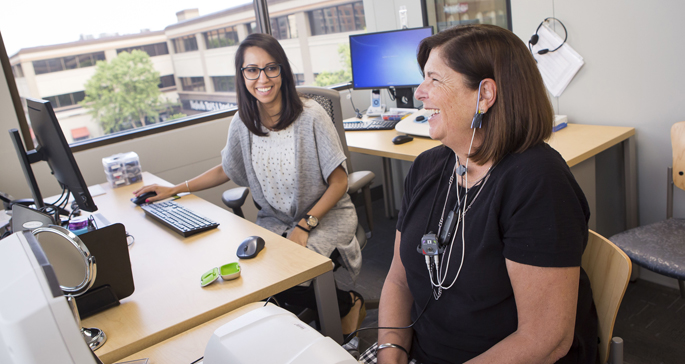
by Kelsey Herbers
If you had asked busy lawyer and physician Ellen Clayton a few years ago what she thought of her hearing aids, she likely would’ve mentioned how much of a headache it was having to change the devices’ batteries.
Not only did she have to keep spare batteries with her at all times, she often received little-to-no warning that her current ones were about to die.
“I’d be in a meeting and the hearing aids would die, and then I just couldn’t hear,” said Clayton.
Advances in technology, such as rechargeable hearing aids, have made it more convenient than ever for patients to consistently use and benefit from their hearing aids. Now, Clayton’s hearing aids hold a charge all day, and if she forgets to charge them at night, she can place them in a special travel case that charges them on the go.
With locations in Nashville, Franklin, Lebanon and Green Hills, Vanderbilt’s hearing aid services provide patients with a variety of unique resources, including walk-in services for hearing aid cleaning and troubleshooting, free classes to learn tips for better listening, and the option to schedule remote appointments with their audiologist via telemedicine visits, thus avoiding travel time for short appointments. VUMC audiologists can even adjust some brands of hearing aids remotely from an app on their computer.
But rechargeable devices and remote visits aren’t the only new options available to patients, said Todd Ricketts, PhD, director of the VUMC Dan Maddox Hearing Aid Research Laboratory.
Integrating hearing aids with a patient’s mobile phone allows them to stream music and videos directly into their ears, take calls and even use their phone as a remote microphone so the voice of the person they’re speaking with in a noisy environment can travel directly through their hearing aids.
“Part of what we do is look at communication needs and abilities and directly target technology for individuals,” said Ricketts. “Depending on a person’s individual needs and how involved they want to get, there’s really a wide range of things we can do for them.”
If a patient has moderate-to-severe hearing loss and is often in changing environments, advanced technology can steer the microphones in their hearing aids in the direction of the loudest speaker while simultaneously attenuating noise from other directions. Some device models can even detect which of a patient’s two hearing aids is picking up the best signal and share it with the opposite hearing aid to amplify sound.
Patients who frequent specific locations can assign a geotag through an app on their phone that automatically reverts their hearing aids’ settings back to how they were adjusted the last time the patient entered that environment whenever they return.
For patients with mild hearing loss and less complex needs, many hearing aid models are simply better than they used to be at detecting and amplifying desired sounds while minimizing background noise. They’re also less noticeable to other people.
Vanderbilt’s research team works with all the major hearing aid manufacturers to stay abreast of new features and to provide feedback they receive from patients in both the research and clinic setting.
“That trusting relationship allows us to really know what’s going on in the hearing aids and to exchange information with the manufacturer in a way that can help our patients,” said Ricketts.
“And because our clinic and clinicians are in the same building as our research labs, we can immediately share the things we learn. Our clinic can apply evidence-based practices as we find out what matters most and least to patients.”
Audiologists in VUMC’s Department of Hearing and Speech Sciences treat patients from infancy to geriatric ages, working with each individual to determine the best device, settings and accessories for their lifestyle.
“We want to help people improve their communication so they can stay engaged with the world around them and have as fulfilling a life as possible,” said Gina Angley, AuD, associate director of Adult Amplification in the Department of Hearing and Speech Sciences.
For Clayton, nothing beats the fact that her hearing aids have helped her become more engaged in her day-to-day life.
“It’s very similar to how I feel about my glasses,” said Clayton. “I sure do like it better when I can see than when I can’t, and I sure do like it better when I can hear than when I can’t. Once I had the hearing aids, there was no going back.”
Discounts on hearing aids are offered year-round for current VUMC employees and seasonally for retired VUMC employees.
For more information or to schedule an appointment, call 615-936-5000.












